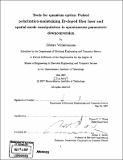Tools for quantum optics : pulsed polarization-maintaining Er-doped fiber laser and spatial mode manipulation in spontaneous parametric downconversion
Author(s)
Venkatraman, Dheera
DownloadFull printable version (2.470Mb)
Alternative title
Picosecond polarization-maintaining Er-doped fiber laser for quantum optics and the construction of a high-flux non-degenerate entangled photon pair source
Other Contributors
Massachusetts Institute of Technology. Dept. of Electrical Engineering and Computer Science.
Advisor
Franco N.C. Wong.
Terms of use
Metadata
Show full item recordAbstract
Two separate projects were undertaken to improve technology for entangled photon sources, useful for quantum optics. In one project, a pulsed, mode-locked erbium-doped fiber laser, designed to be used as a seed laser for a 390 nm source, was built using polarization-maintaining components to address polarization drift. The fiber laser operated at a center wavelength of 1560.0 nm with an output power of 1 to 2.5 mW, and mode-locked with a repetition rate of 31.1 MHz. The laser also exhibited bandwidth tunability from 0.045 to 0.095 nm, as a function of the input pump power. A commercial 5 W erbium-doped fiber amplifier and a second harmonic generation crystal were used to obtain pulses at 780 nm with an average power of 3 W. The next second harmonic generation stage, for generating the desired 390 nm output, remains to be built. In the second project, we tried to optimize the coupling efficiency of light generated from spontaneous parametric downconversion (SPDC) into single-mode optical fibers, which are useful for transporting entangled photons. Using a setup with a tunable 532 nm pump waist in a nonlinear crystal, we achieved an effective coupling efficiency of 48.8% of the 797 nm signal light into a single-mode fiber, higher than previously obtained in the laboratory. Efficient single-mode operation of SPDC would enable the construction of a high-flux fiber-coupled source of nondegenerate entangled photons at 797 nm and 1600 nm.
Description
Thesis (M. Eng.)--Massachusetts Institute of Technology, Dept. of Electrical Engineering and Computer Science, 2007. Includes bibliographical references (p. 50-52).
Date issued
2007Department
Massachusetts Institute of Technology. Department of Electrical Engineering and Computer SciencePublisher
Massachusetts Institute of Technology
Keywords
Electrical Engineering and Computer Science.